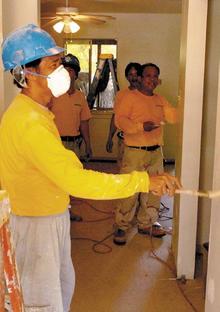Shortcuts
Keyboard Shortcuts
MainBoss lets you use the same sort of shortcut keys that other Windows programs use. For example, Ctrl+C copies text and Ctrl+V pastes it. Using these can save you a good deal of time, especially if you're doing repetitive work (when initially setting up data tables or when you're creating new records that have a lot in common with existing records). Other standard Windows shortcuts (e.g. Ctrl+X for "cut") also work.
Another simple shortcut is using the Tab key: in any editor window, Tab moves from one field to the next. For example, if you're filling out a work order, you can fill in a field, type Tab, then fill in the next field—you don't have to take your hands off the keyboard to use the mouse. In this way, you can quickly go through all the fields in the window (just skipping any fields that you don't want to fill in). Note that Ctrl+Tab goes backward from one field to the previous field.
If you press the Alt key, you'll see underlines appear under single characters on many clickable buttons. For example, pressing Alt in a table viewer will change the "Edit" button so it reads "Edit" and will change "Print" into "Print". This means that instead of clicking on a particular button, you can use a shortcut consisting of the Alt key and the underlined letter. Alt+E is the same as clicking "Edit"; Alt+P is the same as clicking "Print"; and so on.
Getting Creative with Multiple Selection
Many fields in many windows let you select multiple values. For example, the field for assigning people to work orders let you assign several people simultaneously to the same work order.
But what if you want to assign the same person to multiple work orders? You can do the same thing, just by starting at the right record. For example, suppose you want to assign Pat to several different work orders. You just have to go to Pat's record in the Work Order Assignees table. Then, in the Work Order Assignments section, click New Work Order Assignment. The resulting window will let you select any number of work orders to which Chris should be assigned.
This points up an important fact: sometimes shifting your perspective (e.g. shifting from work order records to assignee records) lets you use MainBoss more quickly and easily to do a particular job.
Note: To select individual entries in a multiple selection list, hold down the Ctrl key and then click on the entries you want to select.
You can select a consecutive set of entries by holding down the standard mouse button, then sweeping the mouse across the entries. You can also select a consecutive set of entries by holding down the Shift key, then clicking the first and last entries in the set.
Clarifying the Scheduling Basis
When setting up a schedule for planned maintenance, some users seem to be confused by the concept of "scheduling basis". Here's the easiest way to think of it: the scheduling basis is the last time the job was done before you started using MainBoss.
For example, suppose a particular vehicle needs its oil changed every three months. If you set up a unit maintenance plan describing the oil change and you say the job has to be done every three months, MainBoss will ask, "Starting when?"
You have to set the scheduling basis for that job: "The last time we did the oil change on this vehicle was June 15." Once you record this date, MainBoss can calculate when all future oil changes have to be done. The scheduling basis is the starting point for the schedule.
The same applies for maintenance done according to meter readings. If maintenance on a piece of equipment has to be done every 100 hours of operation, then you have to tell MainBoss what the meter reading was the last time the job was done. Once MainBoss has that information, it can set up a schedule for future maintenance jobs every 100 hours.
Recent versions of MainBoss let you set the scheduling basis for several jobs at once, using the Change Multiple Schedule Basis button. This lets you set the same scheduling basis date (or meter reading) for several unit maintenance plans at once. This is particularly helpful when you first install MainBoss, especially if the precise date of a maintenance job doesn't matter much—"We did all those jobs sometime last fall...so let's set their scheduling basis to October 15; that's close enough."




